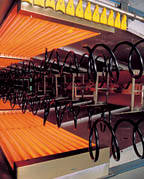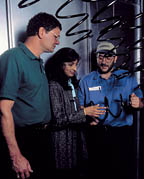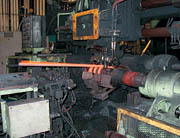The Mother of Invention

Just ask NHK—Associated Spring Suspension Components Inc. (NASCO), a manufacturer of suspension coil springs and trunk-lid torsion bars for the global automotive market in Bowling Green, KY (just across town from GM Bowling Green, the Corvette manufacturing plant featured in the July issue). NASCO’s story illustrates the importance of trying new processes, and how forming partnerships with outside institutions can be important.
In 1997, NASCO was using only electrocoat painting to finish its products on the No. 3 production line. But new orders were increasingly specifying powder coatings. To utilize the capacity it had, NASCO needed to add powder coating to a line that was originally built only for E-coat.
That would have required two separate ovens taking up space on the production floor. But space was limited at NASCO, and company officials feared that having both processes and adding two new curing ovens would negatively impact other parts of the production process.

Like a good neighbor
As the company was deciding how to proceed, a representative from the Tennessee Valley Authority (TVA), which provides power and a host of other services for businesses in the Tennessee Valley region, contacted NASCO. TVA wanted to see if there was any way it could help NASCO increase its manufacturing efficiency, particularly through the use of electricity.
Jeff Johnson, the Bowling Green plant’s manager, said the timing couldn’t have been better. “We were at a point where production was at an all-time high, and we were afraid we couldn’t keep up with demand,” he says.
But the company felt that it was running about as efficiently as it could and was skeptical TVA could help. Nevertheless, they agreed to meet with Sara Madugula, a TVA industrial marketing manager who specializes in the machinery and transportation industries.
TVA’s Industrial Products and Services division “is always looking for opportunities to help industrial customers improve their competitive edge through new technologies, equipment and processes,” Madugula says. “As part of my job, I am constantly checking on distributor-served or directly served customers in the TVA service area that use process heating to cure the coatings on equipment or parts they produce.”
“Of course, I point out the advantages of using electric ovens for this,” she adds. She believed that an electric infrared oven would speed up the powder coating process, increase production and bring the unit cost down. But that didn’t solve the problem of the lack of space in the existing plant for an additional oven.
So Madugula put NASCO in touch with Fostoria Industries Inc. (Fostoria, OH) to see if they could help. Fostoria tapped Bob Stroman, its Midwest district sales manager, Process Heat Division, to see what he could come up with.
His first idea was to add an IR boost to the outside of the oven, a relatively conventional idea. But squeezing it in would have created problems, and additional equipment would need to be purchased.

Back to the drawing board
Stroman returned to Fostoria to confer with colleagues about an alternative. Coincidentally, Fostoria Industries had been working for about six months on new technology that involved putting an IR boost inside a convection oven rather than as an addition to the oven. “Our people said we have this new system far enough along that we can build it,” Stroman recalls. “We discussed the benefits with NASCO and they got pretty excited.”
Within two months of signing the contract, the system was built; a week after that, it had been installed. NASCO’s needs “just pushed us into developing the technology faster,” Stroman says. “Now it’s standard equipment.”
The system employs quartz tubes and insulated board as reflectors. “Quartz tubes have to be used because they are basically impervious to the high oven temperatures,” Stroman says.
“We also went to insulated board because it, too, can take any type of temperature,” Stroman adds. “The surface of the board reaches such a temperature that the board becomes a secondary IR emitter. It also reaches high enough temperatures that it’s basically self-cleaning.
“So the whole thing fell together real nice. It doesn’t take up any extra floor space, it’s self-cleaning, and it’s basically 100% efficient.” Any heat that isn’t absorbed into the product is used by the oven, which reduces the amount of heat needed from the burners.
The new combination oven was installed on the third of NASCO’s four finishing lines. It was such a success—it increased production and reduced energy requirements without hindering the production process elsewhere in the plant—that the company has added IR to other lines.
Innovative manufacturing
“The concept behind NASCO’s manufacturing process is to keep as much of the manufacturing process in-house as possible,” Johnson says. “Other than making the steel and rolling it, we do everything else.”
NASCO receives its raw steel in two-ton coils of wire rod, which is then processed using one of two methods.
On the bar-turning line, which turns the steel coil into cut-to-length bar, the wire is straightened and its outer surface is peeled with a carbide tool to remove defects before being cut. The tools are NC-controlled. “We have excellent control over the finished diameter and also the flying sheer for the cut length,” Johnson says.
The other process is called cold drawing. As on the bar-turning line, the steel coil is straightened, but it is prepared by shot-blasting the surface and then pulling it through a dye with an oil drawing medium. A pneumatically controlled hydraulic sheer is used to produce a consistent cut length.
The cold-drawing process, which reduces the diameter of the bar in a range of 14 to 19%, requires the steel to have a superior surface quality, whereas turning is a little more tolerant of steel with minor surface imperfections. Cold drawing is a faster and more consistent process, but it is less flexible and doesn’t allow NASCO to vary the diameter of the coils.
Varying the diameter is important for some of NASCO’s products. Using a proprietary design method it calls “L-Shaped Design,” NASCO can, for example, taper one or both ends of a coil. This allows the company to produce coils that help automakers produce cars that better handle bumpy roads and have smoother rides.
To ensure proper quality on the cold-drawing line, the plant uses several types of in-line inspection equipment. A rotary eddy current checks for superficial, longitudinal flaws; a coil eddy current checks for transverse flaws; and an ultrasonic tester detects potential interior defects that may have been imparted during the drawing process. NASCO says it was one of the first spring makers in the world to have three inspection devices built into its cold-drawing equipment.
Once the bars are prepared, they’re introduced to the main line, which has four hot-wound coil-spring lines. On three of the lines the paint systems were supplied by Eisenmann Corp. (Crystal Lake, IL) and the original one by Trinity Industrial Services, a Japanese company with offices in Georgetown, KY. Three of the lines use natural-gas furnaces to heat the bar to forming temperature; the fourth—and newest—line uses induction heating. When the bars reach the appropriate temperature, about 1,800?F, the springs are formed on a mandrel using several hydraulic numerical control (NC) forming machines.
“The NC control gives us quite a bit of flexibility in making the spring profile as it rests on the mandrel,” Johnson says. “We’re able to use a lot of cassette tooling, so our changeovers are rather short, compared to other ways of manufacturing hot-wound suspension springs.”
After the springs are formed, they are oil quenched and routed to a natural-gas-fired tempering furnace. The springs exit into the conditioning area where warm setting, shot peening and presetting are performed.
The setting process puts a permanent yield into the spring so that it doesn’t sag over the life of the product. Shot peening involves blasting steel shot at the surface of the wire to impart a compressive residual stress, which greatly enhances the fatigue life, or life cycle, of the part in service.

Coating and curing
There are two different pretreatment systems, one with seven stages, the other with eight. Two of the finishing lines use the eight-stage system, which adds a sealer to the springs that are electrocoated. PPG (Pittsburgh) supplies the chemicals for the system that pretreats parts to be E-coated and Henkel Surface Technologies (Madison Heights, MI) supplies the pretreatment chemicals for parts that are powder coated.
On lines one and two, electrostatic spray guns are used to coat parts with an epoxy powder coating supplied by Akzo Nobel (Louisville, KY). Lines three and four are able to powder coat, E-coat or apply an E-coat primer followed by a powder topcoat. These two lines now use IR to dry the E-coat primer before powder coating.
“On line three, because it was originally designed for E-coat and has a high-velocity convection cure oven, we put banks of IR in the entryway of the oven so that we can gel the powder coating before it hits the high-turbulent area of the oven,” Johnson says. Line three uses IR for both dewatering of the E-coat and to gel the powder before it enters the cure oven. Line four uses IR only for dewatering.
All of the spring coils cure for about 20 minutes at temperature. “We use low-temperature-cure paints because of the shot peening, which is a very critical part of our manufacturing,” Johnson says. “Heat will relax the stress, so we use as little heat as possible.”
SIDEBAR:
World-Class Manufacturing
NHK—Associated Spring Suspension Components Inc. (NASCO) (Bowling Green, KY) was established in 1986 as a joint venture between NHK Spring Co. LTD (Yokohama, Japan) and Associated Spring, Barnes Group (Bristol, CT). The plant, which employs about 210 people, is situated on 46 acres of land and encompasses about 278,000 square feet under one roof. The technologically advanced QS-9000-certified facility houses numerically controlled hot-wound coil spring lines, material-turning lines, cold-drawing equipment and a trunk-lid torsion-bar facility.
“The concept behind NASCO’s manufacturing process is to keep as much of the manufacturing process in-house as possible,” says Jeff Johnson, NASCO's plant manager. “Other than making the steel and rolling it, we do everything else.” Though its main product is coil springs, the company also produces trunk-lid torsion bars and stabilizer links. NASCO produced nearly nine million coil springs in 2002.
To ensure its status as a world-class supplier, NASCO places a great deal of emphasis on continuous quality improvement through defect prevention and preventive maintenance. One full day each month is spent performing routine maintenance on all machinery and equipment and bringing employees together to discuss methods for improvement. During the meetings, employees review the previous month’s productivity results, set new goals and discuss upcoming projects.
The company says it is responsible for breaking down barriers that existed in older manufacturing methods. It points, for example, to large-scale improvements made through numerous computer-controlled features and a dual-chamber heating furnace. The improvements help control decarburization and spring-load characteristics.
The company also says it was one of the first spring makers in the world to have three inspection devices built into its cold-draw equipment. The inspection devices are a rotary eddy current that checks for superficial, longitudinal flaws; a coil eddy current for transverse flaw detection; and an ultrasonic tester to detect potential interior defects.
In addition to several community awards, NASCO has received various types of customer awards from Aeroquip-Inoac, Auto Alliance, New United Motor Manufacturing, Nissan, Subaru-Isuzu and Toyota. Other customers include GM, Ford and Honda.
SIDEBAR:
TVA—More Than Just an Electricity Wholesaler
Though most people may think of the Tennessee Valley Authority (TVA) as a generator of electricity, its role is, and always has been, much broader. It played a key role in helping NASCO implement new technology and grow its business (see main story).
TVA, a federal corporation and the nation's largest public power producer, was a product of President Franklin Roosevelt’s New Deal formed in 1933. Envisioning TVA as a totally different kind of agency, Roosevelt asked Congress to create “a corporation clothed with the power of government but possessed of the flexibility and initiative of a private enterprise.”
From the start, TVA established a unique problem-solving approach to fulfilling its mission. Each issue TVA faced—whether it was power production, navigation, flood control, malaria prevention, reforestation or erosion control—was studied in its broadest context and in relation to other issues.
Today it also provides a host of programs and services most people probably don’t know about. Through TVA's Customer Service & Marketing organization, TVA provides customized industry-specific assistance to its industrial customers. TVA has a team of local, regional and national industrial marketing experts to provide assistance in the application of energy-based technologies to solve manufacturing, coatings, safety and environmental concerns. The staff analyzes plant problems, provides equipment application information and compares costs of various equipment alternatives.
TVA also offers a full range of economic development services to support new and existing industries, including economic development loans, site-selection assistance and a menu of technical-support assistance.
To find out more, visit www.tva.gov or call TVA's Industrial Products and Services at 615-232-6815.
Looking for a reprint of this article?
From high-res PDFs to custom plaques, order your copy today!



